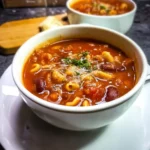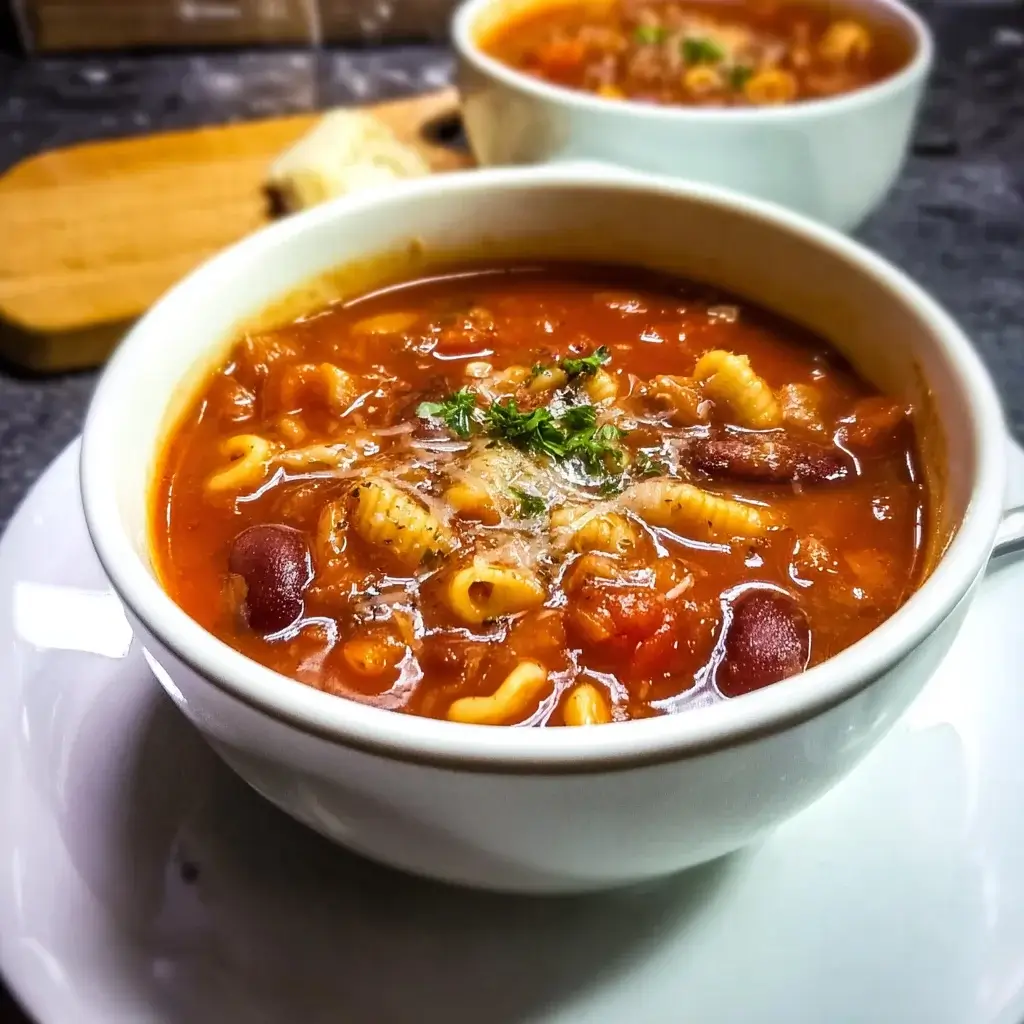There are certain dishes that feel less like a meal and more like a hug in a bowl. For me, Pasta e Fagioli has always been the ultimate culinary embrace. I didn’t grow up with an Italian nonna, but I learned about this soup from a well-worn cookbook at a friend’s house, its pages stained with tomato and olive oil. The description called it Italian peasant food, a humble dish designed to stretch simple ingredients into a hearty, soul-warming meal. I was intrigued. The first time I made it, my tiny apartment kitchen filled with the incredible aroma of sautéed pancetta, garlic, and herbs. As the soup simmered, thickening into a rustic, ruby-red stew, I knew I had found something special. My family fell in love with it instantly. It became our go-to “bad day” cure, our “first cold day of fall” tradition, and our favorite way to feed a crowd on a budget. This recipe is the culmination of years of tweaking—a version that I believe perfectly balances authentic, rustic flavor with the comforting, crowd-pleasing character that makes this soup a legend.
The Ultimate Hearty Pasta e Fagioli Soup Recipe
Pasta e Fagioli, which literally translates to “pasta and beans,” is a cornerstone of Italian cucina povera (peasant cooking). It’s a testament to the genius of turning humble pantry staples into something deeply satisfying and extraordinarily delicious. This isn’t a thin, brothy soup; it’s a thick, stew-like concoction, rich with savory aromatics, tender beans, and perfectly cooked pasta. While there are countless regional variations, this recipe focuses on creating a robust, flavorful base that is both authentic and incredibly easy to make. Often compared to the popular version at Olive Garden, this homemade recipe boasts a deeper, more rustic flavor profile that will transport you straight to a cozy Italian trattoria. Prepare a big pot, because everyone will be asking for a second bowl.
The Foundation of Flavor: Your Ingredients
A truly great Pasta e Fagioli relies on building layers of flavor from simple, high-quality ingredients. We’ll break them down into their key roles in the soup.
For the Aromatic Base (Soffritto):
- Pancetta: 4 oz, finely diced. This is Italian cured pork belly, and it’s the secret to a deeply savory, authentic flavor base. It renders a flavorful fat in which we’ll cook our vegetables. If you can’t find pancetta, thick-cut bacon is a good substitute.
- Olive Oil: 1 tablespoon. Used to help the pancetta start rendering without sticking.
- Yellow Onion: 1 large, finely chopped.
- Carrots: 2 medium, finely chopped.
- Celery: 2 stalks, finely chopped. (The onion, carrot, and celery combination is the holy trinity of Italian cooking, known as soffritto.)
- Garlic: 4-6 cloves, minced. Use fresh garlic for the best, most pungent flavor.
For the Heart of the Soup:
- Chicken or Vegetable Broth: 6 cups, low-sodium. Using a low-sodium broth allows you to control the final saltiness of the soup.
- Crushed Tomatoes: 1 can (28 oz). Crushed tomatoes provide the perfect texture—a thick, rich base with small pieces of tomato throughout.
- Cannellini Beans: 1 can (15 oz), rinsed and drained. These are creamy, white kidney beans that are traditional in Pasta e Fagioli.
- Red Kidney Beans: 1 can (15 oz), rinsed and drained. Adds a different texture and color, making the soup heartier.
- Dried Herbs: 1 teaspoon dried oregano and 1 teaspoon dried basil. These pantry staples add a classic Italian herbal backbone.
- Bay Leaf: 1. This adds a subtle, almost medicinal depth that you might not be able to pinpoint, but you’d miss it if it were gone.
- Parmesan Rind: 1 (optional, but highly recommended). This is a game-changing secret ingredient! As the soup simmers, the rind softens and releases a salty, umami-rich flavor that infuses the entire pot. Just remember to remove it before serving.
- Salt and Black Pepper: To taste.
For the Pasta and Final Flourishes:
- Ditalini Pasta: 1 cup, dry. This small, tube-shaped pasta is the classic choice. Its size ensures you get a perfect pasta-to-bean ratio in every spoonful.
- Fresh Parsley: ¼ cup, chopped. Adds a bright, fresh finish that cuts through the richness of the soup.
- For Garnish (Optional):
- Freshly grated Parmesan cheese
- A drizzle of high-quality extra-virgin olive oil
- Red pepper flakes
Building the Masterpiece: Step-by-Step Instructions
Follow these detailed phases to build your soup from a simple base to a complex, harmonious bowl of comfort.
Phase 1: Create the Savory Flavor Base
- Render the Pancetta: Place a large Dutch oven or heavy-bottomed pot over medium heat. Add the diced pancetta and the tablespoon of olive oil. Cook, stirring occasionally, for about 5-7 minutes, until the pancetta has rendered its fat and become crispy and golden brown.
- Sauté the Soffritto: Do not drain the rendered fat. This is liquid gold! Add the chopped onion, carrots, and celery directly to the pot. Sauté for 8-10 minutes, stirring occasionally, until the vegetables have softened and the onion is translucent. This slow sauté builds a deep, sweet foundation for the soup.
- Bloom the Aromatics: Add the minced garlic and cook for another minute until fragrant. Be careful not to let the garlic burn, as it will become bitter. Stir in the dried oregano and dried basil and cook for 30 more seconds to “bloom” the herbs, which awakens their flavor.
Phase 2: Simmer the Soup to Perfection
- Deglaze the Pot: Pour in about ½ cup of the broth and use a wooden spoon to scrape up any browned bits (called fond) from the bottom of the pot. These bits are packed with concentrated flavor.
- Add Liquids and Beans: Add the rest of the broth, the can of crushed tomatoes, the rinsed cannellini beans, and the rinsed kidney beans. Stir everything to combine.
- The Secret Ingredients: Tuck the bay leaf and the Parmesan rind (if using) into the soup, ensuring they are submerged.
- Simmer and Meld: Bring the soup to a boil, then immediately reduce the heat to low. Cover the pot and let the soup simmer gently for at least 30 minutes, but for the best flavor, allow it to simmer for 1 hour. This long, slow simmer allows all the flavors to meld together into a cohesive, delicious whole.
- Thicken the Soup (Optional): For a thicker, creamier consistency, you can use an immersion blender to pulse the soup a few times directly in the pot. Alternatively, scoop out about 1 ½ cups of the soup (making sure to get plenty of beans), blend it until smooth in a regular blender, and then stir it back into the pot.
Phase 3: Cook the Pasta and Finish
- Prepare the Pasta: This is a crucial step. For the best results and to prevent mushy leftovers, it is highly recommended to cook the pasta separately. Bring a separate small pot of salted water to a boil and cook the ditalini according to package directions until al dente. Drain it well.
- Final Seasoning: Before adding the pasta, taste the soup and season generously with salt and fresh black pepper. The amount of salt will depend on the saltiness of your broth and pancetta. Remove and discard the bay leaf and the Parmesan rind.
- Combine and Serve: Stir the chopped fresh parsley into the soup. To serve, place a scoop of the cooked ditalini into each individual serving bowl and ladle the hot soup over the top. This keeps the pasta perfectly textured.
Nutrition Facts
This nutritional information is an estimate and can vary based on the specific ingredients used (e.g., type of broth, pancetta vs. bacon).
- Servings: This recipe yields approximately 8 hearty servings.
- Calories Per Serving: Approximately 350-400 calories per serving.
Preparation Time
This soup benefits from a slow simmer, but the active preparation time is quite manageable.
- Prep Time: 20 minutes (chopping vegetables)
- Cook Time: 1 hour 15 minutes
- Total Time: Approximately 1 hour 35 minutes
How to Serve Pasta e Fagioli
Serving this soup is all about enhancing its rustic, comforting nature. Here’s how to present it for the ultimate experience:
- The Perfect Garnishes: A great bowl of Pasta e Fagioli becomes an unforgettable one with the right toppings.
- A Blizzard of Parmesan: Offer a block of Parmesan cheese and a microplane or grater at the table for a fresh, nutty, and salty finish.
- A Luxurious Drizzle: A final, small drizzle of high-quality, peppery extra-virgin olive oil over each bowl right before serving adds a fruity, luxurious aroma and flavor.
- A Touch of Heat: A sprinkle of red pepper flakes for those who enjoy a little kick.
- Crusty Bread is Non-Negotiable: This thick, stew-like soup demands a good, crusty bread for sopping up every last drop from the bowl.
- Serve with a loaf of rustic Italian bread, ciabatta, or a crusty sourdough.
- For an extra treat, toast thick slices of bread, rub them with a raw garlic clove, and drizzle with olive oil to make simple bruschetta.
- A Simple Side Salad: To complete the meal, pair the soup with a simple green salad dressed in a light lemon vinaigrette. The fresh, acidic greens provide a perfect contrast to the rich, hearty soup.
Additional Tips for Soup Supremacy
These five expert tips will elevate your Pasta e Fagioli from great to legendary.
1. The Parmesan Rind is Magic:
Never throw away the hard rind from a wedge of Parmesan cheese. Store it in a bag in the freezer. When making soups, stews, or tomato sauces, drop the rind into the pot as it simmers. It won’t melt completely, but it will infuse the entire dish with a deep, savory, umami flavor that you can’t get any other way. Just remember to fish it out before serving!
2. The Great Pasta Debate: In the Pot vs. Separate
Many recipes call for cooking the pasta directly in the soup pot. While this is convenient for a one-pot meal, it has a major drawback: the pasta will continue to soak up broth as it sits, resulting in mushy pasta and an overly thick soup in any leftovers. By cooking the pasta separately and adding it to individual bowls upon serving, you guarantee perfectly al dente pasta every time and your leftover soup will be just as delicious the next day.
3. The Bean-Thickening Trick:
For an authentically thick and creamy soup without adding any cream, use the beans themselves as a thickener. After the soup has simmered, scoop out a cup or two of the beans and broth. Mash them with a fork into a rough paste or blend them until smooth, then stir the mixture back into the soup. This releases the starches from the beans and gives the broth a wonderful body.
4. Making It Vegetarian or Vegan:
This soup is incredibly easy to adapt. To make it vegetarian, simply omit the pancetta and use 2-3 tablespoons of olive oil to sauté the vegetables. Use a high-quality vegetable broth, and be sure to use the Parmesan rind for that umami punch. To make it vegan, follow the vegetarian instructions but omit the Parmesan rind. You can add a teaspoon of miso paste or a splash of soy sauce at the end to add a savory, umami depth.
5. Freezing and Reheating for Future Comfort:
Pasta e Fagioli freezes beautifully, if you cook the pasta separately. Let the soup (without any pasta in it) cool completely. Ladle it into freezer-safe containers or bags, leaving a little room for expansion. It can be frozen for up to 3 months. To serve, thaw it overnight in the refrigerator and reheat gently on the stovetop. Cook a fresh batch of ditalini to add to the bowls when you’re ready to eat.
Frequently Asked Questions (FAQ)
1. What is the difference between Pasta e Fagioli and Minestrone?
This is a classic question! While both are hearty Italian vegetable soups, the main difference is their focus. Pasta e Fagioli, as the name implies, is centered around the “pasta and beans.” It’s typically thicker and more stew-like. Minestrone is generally a more brothy soup that celebrates a wider variety of seasonal vegetables (like zucchini, green beans, and leafy greens) and can sometimes, but not always, contain beans and pasta.
2. Can I use different kinds of beans or pasta?
Absolutely! This recipe is very forgiving. For beans, you can use great northern beans, pinto beans, or even chickpeas. For the pasta, any small shape works well. Try small shells, elbow macaroni, or tubettini. Just be sure to cook it separately for the best results.
3. Is this recipe like the Olive Garden Pasta e Fagioli?
This recipe creates a more traditional, rustic Italian-style soup. The Olive Garden version is a beloved American adaptation that is also delicious but has some key differences, most notably its use of ground beef instead of pancetta and a more tomato-forward, brothy base. To make this recipe closer to that version, you could substitute 1 lb of browned ground beef for the pancetta and use a bit more broth for a thinner consistency.
4. How can I make my soup thicker or thinner?
- To make it thicker: Use the bean-thickening trick mentioned in the tips section. You can also let it simmer uncovered for the last 15-20 minutes to allow some of the liquid to evaporate.
- To make it thinner: Simply stir in a bit more broth until it reaches your desired consistency. Adjust the seasoning as needed.
5. Can I make this in a slow cooker or Instant Pot?
Yes!
- Slow Cooker: Sauté the pancetta and vegetables on the stovetop first, then transfer them to the slow cooker. Add the remaining soup ingredients (except pasta and parsley) and cook on LOW for 6-8 hours or on HIGH for 3-4 hours. Cook the pasta separately before serving.
- Instant Pot: Use the “Sauté” function to cook the pancetta and vegetables in the pot. Deglaze, then add the remaining soup ingredients (except pasta and parsley). Seal the lid and cook on High Pressure for 15 minutes, followed by a 10-minute natural release. Cook the pasta separately.

Pasta e Fagioli Soup recipe
Ingredients
For the Aromatic Base (Soffritto):
-
Pancetta: 4 oz, finely diced. This is Italian cured pork belly, and it’s the secret to a deeply savory, authentic flavor base. It renders a flavorful fat in which we’ll cook our vegetables. If you can’t find pancetta, thick-cut bacon is a good substitute.
-
Olive Oil: 1 tablespoon. Used to help the pancetta start rendering without sticking.
-
Yellow Onion: 1 large, finely chopped.
-
Carrots: 2 medium, finely chopped.
-
Celery: 2 stalks, finely chopped. (The onion, carrot, and celery combination is the holy trinity of Italian cooking, known as soffritto.)
-
Garlic: 4-6 cloves, minced. Use fresh garlic for the best, most pungent flavor.
For the Heart of the Soup:
-
Chicken or Vegetable Broth: 6 cups, low-sodium. Using a low-sodium broth allows you to control the final saltiness of the soup.
-
Crushed Tomatoes: 1 can (28 oz). Crushed tomatoes provide the perfect texture—a thick, rich base with small pieces of tomato throughout.
-
Cannellini Beans: 1 can (15 oz), rinsed and drained. These are creamy, white kidney beans that are traditional in Pasta e Fagioli.
-
Red Kidney Beans: 1 can (15 oz), rinsed and drained. Adds a different texture and color, making the soup heartier.
-
Dried Herbs: 1 teaspoon dried oregano and 1 teaspoon dried basil. These pantry staples add a classic Italian herbal backbone.
-
Bay Leaf: 1. This adds a subtle, almost medicinal depth that you might not be able to pinpoint, but you’d miss it if it were gone.
-
Parmesan Rind: 1 (optional, but highly recommended). This is a game-changing secret ingredient! As the soup simmers, the rind softens and releases a salty, umami-rich flavor that infuses the entire pot. Just remember to remove it before serving.
-
Salt and Black Pepper: To taste.
For the Pasta and Final Flourishes:
-
Ditalini Pasta: 1 cup, dry. This small, tube-shaped pasta is the classic choice. Its size ensures you get a perfect pasta-to-bean ratio in every spoonful.
-
Fresh Parsley: ¼ cup, chopped. Adds a bright, fresh finish that cuts through the richness of the soup.
-
For Garnish (Optional):
-
Freshly grated Parmesan cheese
-
A drizzle of high-quality extra-virgin olive oil
-
Red pepper flakes
-
Instructions
Phase 1: Create the Savory Flavor Base
-
Render the Pancetta: Place a large Dutch oven or heavy-bottomed pot over medium heat. Add the diced pancetta and the tablespoon of olive oil. Cook, stirring occasionally, for about 5-7 minutes, until the pancetta has rendered its fat and become crispy and golden brown.
-
Sauté the Soffritto: Do not drain the rendered fat. This is liquid gold! Add the chopped onion, carrots, and celery directly to the pot. Sauté for 8-10 minutes, stirring occasionally, until the vegetables have softened and the onion is translucent. This slow sauté builds a deep, sweet foundation for the soup.
-
Bloom the Aromatics: Add the minced garlic and cook for another minute until fragrant. Be careful not to let the garlic burn, as it will become bitter. Stir in the dried oregano and dried basil and cook for 30 more seconds to “bloom” the herbs, which awakens their flavor.
Phase 2: Simmer the Soup to Perfection
-
Deglaze the Pot: Pour in about ½ cup of the broth and use a wooden spoon to scrape up any browned bits (called fond) from the bottom of the pot. These bits are packed with concentrated flavor.
-
Add Liquids and Beans: Add the rest of the broth, the can of crushed tomatoes, the rinsed cannellini beans, and the rinsed kidney beans. Stir everything to combine.
-
The Secret Ingredients: Tuck the bay leaf and the Parmesan rind (if using) into the soup, ensuring they are submerged.
-
Simmer and Meld: Bring the soup to a boil, then immediately reduce the heat to low. Cover the pot and let the soup simmer gently for at least 30 minutes, but for the best flavor, allow it to simmer for 1 hour. This long, slow simmer allows all the flavors to meld together into a cohesive, delicious whole.
-
Thicken the Soup (Optional): For a thicker, creamier consistency, you can use an immersion blender to pulse the soup a few times directly in the pot. Alternatively, scoop out about 1 ½ cups of the soup (making sure to get plenty of beans), blend it until smooth in a regular blender, and then stir it back into the pot.
Phase 3: Cook the Pasta and Finish
-
Prepare the Pasta: This is a crucial step. For the best results and to prevent mushy leftovers, it is highly recommended to cook the pasta separately. Bring a separate small pot of salted water to a boil and cook the ditalini according to package directions until al dente. Drain it well.
-
Final Seasoning: Before adding the pasta, taste the soup and season generously with salt and fresh black pepper. The amount of salt will depend on the saltiness of your broth and pancetta. Remove and discard the bay leaf and the Parmesan rind.
-
Combine and Serve: Stir the chopped fresh parsley into the soup. To serve, place a scoop of the cooked ditalini into each individual serving bowl and ladle the hot soup over the top. This keeps the pasta perfectly textured.
Nutrition
- Serving Size: one normal portion
- Calories: 350-400




